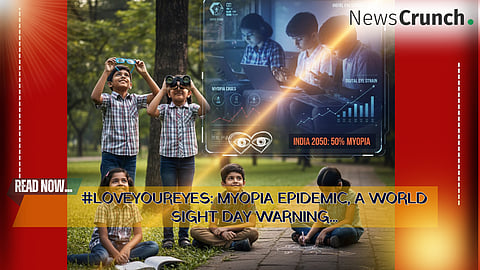

Threat from Smartphone
Modern lifestyles have undergone dramatic transformation, with digital screens now embedded in almost every aspect of daily life. Activities related to work, education, recreation, and even social interaction are frequently mediated through smartphones, computers, and tablets. This pervasive screen exposure is no longer limited to adults; children are also experiencing a marked rise in digital engagement.
The consequences are clear. Rising incidences of eye conditions such as dry eyes, vision impairment, and myopia (nearsightedness) are being reported, especially among the younger population. Recent scientific studies have documented a doubling of childhood myopia cases worldwide, directly linked to factors such as decreased outdoor activity, increased screen time, and reduced physical movement—circumstances that now characterize the daily routines of many families.
World Sight Day, held annually on the second Thursday of October, underscores the importance of eye health and blindness prevention. Ophthalmologists are highlights a common oversight: “People are so careless with their eyes. We use them literally every waking moment, but nobody thinks to give them a break.” Unlike other organs, the eyes seldom receive conscious rest, despite their continuous use.
Rise in Vision Impairment
The burden on the eyes has intensified, with children increasingly shifting from traditional print media to digital screens. This transition is contributing to a rise in vision impairment. Data indicates that approximately 2.2 billion people worldwide currently experience some form of vision impairment. Projections suggest that, by 2040, over half of the world’s children may require corrective lenses.
According to the World Health Organization (WHO), at least 2.2 billion people globally live with preventable or treatable vision impairment. The economic burden is significant, with annual costs due to unaddressed vision loss estimated at $411 billion worldwide.
Digital Eye Strain in Children
India faces this challenge acutely as rapid digitization drives widespread lifestyle shifts and a corresponding increase in ocular morbidity. Ophthalmologists report an epidemic of myopia and digital eye strain, particularly among children. The screen, once a tool for convenience, has become a major source of visual stress. The increase in near-work activities, especially following the shift to remote learning during the pandemic, is fuelling a dramatic rise in nearsightedness among the youth.
Recent studies suggest that, without intervention, up to 50% of Indian schoolchildren could develop myopia by 2050, a substantial rise from current rates. Major urban centers, such as Bengaluru, have reported significant spikes in myopia and dry eye syndrome among children—some clinics observed cases rising from 2–3 per month pre-pandemic to 10–16 per week post-pandemic, with consistently high rates persisting today.
Myopia Threat to South-East Asia
This trend mirrors global patterns. The WHO projects that in regions such as South-East Asia, myopia prevalence may reach as high as 90% by 2050. High myopia increases the risk of severe complications, including retinal detachment and glaucoma, which can result in permanent vision loss.
Research indicates that children spending less than one hour outdoors daily experience faster progression of myopia. Studies published in the Indian Journal of Ophthalmology have demonstrated that increased outdoor exposure slows the advancement of nearsightedness, likely due to the beneficial effects of natural light and neurochemical regulation within the retina.
Safeguarding Vision: Eye Health across Sectors
It is a common misconception that screen time is the primary threat to eye health, while in reality, risks are distributed across a variety of environments—industrial, medical, and domestic. Initiatives such as World Sight Day emphasize the necessity for stringent eye safety protocols in every setting, not merely as a formality but as an actionable standard.
Occupational eye injuries remain particularly prevalent within sectors like construction, manufacturing, and welding. Neglecting proper eye protection in these environments can result in severe, sometimes irreversible harm. Compliance with established safety regulations—such as ISI (Indian Standards Institute) is mandatory. Experts advocate for the cultivation of a safety-oriented workplace culture, wherein protective equipment like polycarbonate safety glasses, chemical splash goggles, and face shields are routinely utilized and properly maintained.
Clinically, the eye is frequently referred to as a “window to health.” Ophthalmologists and other medical professionals highlight the diagnostic value of routine eye examinations, which can reveal early indicators of systemic illnesses, including hypertension, elevated cholesterol, and, most notably, diabetic retinopathy. The latter is of particular concern in India, where the diabetic population is the second largest globally and diabetic retinopathy
